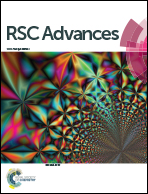Influence of facets and heterojunctions in photoactive bismuth oxyiodide†
Abstract
The role of facetted crystalline nanosheets and heterojunctions in bismuth oxyiodide composites for the photodegradation of phenolic compounds is investigated. Single-crystalline nanosheets with either {001} or {110} planes as the dominant facets were formed by tuning the pH during synthesis. The {001}-facetted BiOI consisted of large crystallites with low surface areas in contrast to the thinner and smaller {110}-facetted platelets. The specific activity per m2 for the photodegradation of p-cresol was ∼5 times higher over the {001} than over the {110}-facetted BiOI which can be correlated to the stronger adsorption of the substrate at the oxygen-rich {001} surface. However, the low surface area of <1 m2 g−1 is a drawback for practical use. Instead, by simple calcination of {110}-facetted BiOI at 350 °C, composites of different BixOyIz phases with closely related crystalline structures were formed. The intimate contact between the phases results in the formation of heterojunctions which greatly improve the photoactivity, even over that of {001}-facetted BiOI. The most active photocatalyst was a composite of Bi7O9I3/α-Bi5O7I which maintained its activity in the presence of chloride and nitrate anions and was recyclable. Scavenger studies revealed that holes were active species for the degradation of p-cresol.


 Please wait while we load your content...
Please wait while we load your content...